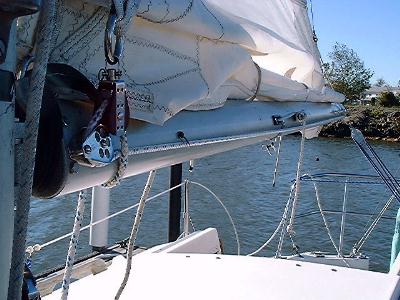






Rigging Photo Page (Text)
Photo Library (Text)
These photos show the single line reefing system I have set up on Pyxis. A line runs from a padeye at the end of the boom up to the reefing clew (cringle), down to a cheek block, forward to another cheek block, up to the reefing tack and back down to a cleat on the boom. It takes about 32' of 5/16 line. Pulling the line in brings down the tack and clew. There is a small double loop of line tied to the reef clew. I connect the snap shackle on the outhaul to it when reefed for better control of the shape of the reefed sail. This has been very useful. It can be difficult to set the reefed main because the reefing line puts tension on the sail slugs and makes them bind in the track. You need to have the reefing line and the outhaul slacked a bit to raise the main and boom high enough to get good tension on the downhaul. I think having a fixed gooseneck and a small winch for the main (a #6 would do) would be better then the sliding gooseneck and downhaul.
Re-Thinking the Reefing System
After struggling with the reefing and not being truely satisfied with any of the set-ups I have tried I tried simplifying as much as possible. I experimented with a no-line system with a traditional hook at the gooseneck and the snap shackle from the outhaul at the clew. To put in the reef I set the topping lift, drop the main to hook the reef ring on the reef hook, switch the outhaul to the reefing clew, raise the main, tension the outhaul and release the topping lift. That's it. I can still tie or leave un-tied the lines to gather the loose sail material as before. I think this approach might work well because the main on the P26 is pretty small and easy to manage and the complexity of line systems may just be more trouble than they are worth. The one issue I foresee is the lateral load on the outhaul wire turning block. This will be fine when the outhaul is tight but until it's tight there may be too wide an ange with nothing to keep the clew at the boom. With my line system the line keeps the clew at the boom (photo). The full sail clew has a slider in the boom track. I might be able to smap the shackle over both the reefing clew (with the loop of line I have on it) and the full sail clew at the same time.